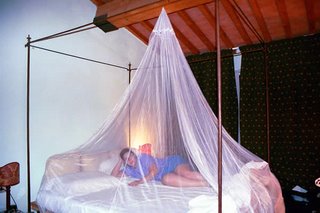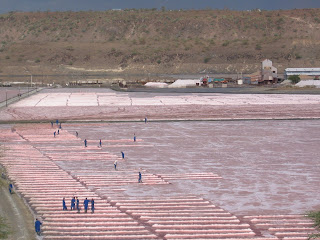:::::::::::::::::::::::::::::::::::::::::::::::::::::::::::::::::::::::::::::::::::::::::::::::::::::
Mud (Swahili : matope)
***** Location: Kenya, other areas
***** Season:Long rains, short rains
***** Category: Earth
*****************************
Explanation
Kenya is a muddy country when it rains. The soil is heavy, and people get busy cultivating and planting seeds as soon as the rains look established. Working on the land is a very muddy job at such times of year! The mud is carried, on people’s shoes, into buses, matatus, churches, shops and offices. Coconut fibre doormats need to be shaken out as soon as the mud has dried overnight, ready for the next day’s deposits.
The major city roads are tarmacked, but as one ventures into the poorer areas at the outskirts of town, and into the rural areas, murram roads take over. These are rightly called mud roads at this time of year, as the floods wash out the mud from between the stones, and the edges (no longer footpaths!) are in any case a mix of mud and flood.
Nairobi has a great variety of mud. In Eastlands, including Kayole, on the way out to Ukambani, the black cotton soil turns into a black, heavy mud, so stodgy and clingy that most of the inhabitants prefer to walk in their bare feet, carrying shoes in plastic bags, ready to put on once they reach town. In Westlands and beyond, moving into Central Province, the red soil turns into a red, much finer sandy mud, which nevertheless clings heavily to one’s hoe or shoe. The city centre has beige soil, which is perhaps the least muddy, as most of it is covered in buildings, parks, streets and pavements!
As the rains fall heavily, over a short period, much of the soil, once turned into mud, is carried away by the rivers towards the sea, which runs brown at the river mouths.

http://corbinball.coronaware.com/assets/eventphotos/art-ke26.jpg
Kenya loses much fertile ground each year as a result. The colonialists tried to limit rainwater erosion by means of terracing; in parts of the country, e.g. Ukambani, this has been moderately effective.
In the rural areas, the rainy season is also the season when mud is used to build or repair traditional mud and wattle houses. While house building is mostly men’s work, house repair is women’s work, and may take up to several days during the rains.
At the end of the rainy season, the mud gradually dries out. For a while, it remains in the shape it took, often resembling bizarre sculptures -- then, with time, it is eroded away and flattened by human, animal and vehicular traffic.
Isabelle Prondzynski
:::::::::::::::::::::::::::::::::::::::::::::::::::::::::::::::::::::::::::::::::::::::::::::::::::::
. MORE PHOTOS
by Caleb David Mutua
:::::::::::::::::::::::::::::::::::::::::::::::::::::::::::::::::::::::::::::::::::::::::::::::::::::
Elephants wallowing in mud -- their colour always reflects the colour of the mud of their habitat!
Look at a great photo here
http://www.pbase.com/flemmingbo/image/55500343
© Flemming Bo Jensen
xxxxxxxxxxxxxxxxxxxxxxxxxxxxx
Two of the many types of mud-built houses in Kenya :

http://www.leavenworthbaptist.com/images/Missions/KenyaTrip/DSC00321_640.jpg
http://www.trekearth.com/gallery/Africa/Kenya/photo276173.htm
*****************************
Worldwide use
Japan
The word mud (doro) just like that is a topic for haiku.
spring mud, haru no doro 春の泥
..... shundei 春泥
kigo for all spring
A phenomen when the snow melts. Mud is usually something one tries to avoid, but in spring it expresses the joy of the long winter now being over soon.
お上人の足袋の春泥ご開帳
o shoonin no tabi no shundei go-kaichoo
spring mud
on the socks of the priest -
showing the secret statue
(Tr. Gabi Greve)
Seiji せいじ
http://www.hb-arts.co.jp/haiku_html/030510kekka.htm
Quoted from
Secret Buddha Statues
by Gabi Greve

秋しぐれ泥人形と生まれて泥
aki shigure doro ningyoo ni umarete doro
sleet in autumn -
born as a mud doll
this mud
source : Keiji Minato. Sep. 2008
Tr. Gabi Greve
Other translation versions are possible.
reference
:::::::::::::::::::::::::::::::::::::::::::::::::::::::::::::::::::::::::::::::::::::::::::::::::::::
Trinidad and Tobago
Kigo for Dry Season ... Feb/March; Spring.
In Trinidad and Tobago, a great part of the fun on the first day of the two-day carnival masquerade, is playing mud mas. Mud mas is a must at Jouvert,( the opening hours, on the first day of Carnival).

www.tntisland.com/images/c2k5-06.jpg
mud smeared bodies
welcome the dawn
jouvert
related words: carnival; jouvert; ole mas; masquerade; street festivals.
Gillena Cox
*****************************
Things found on the way
*****************************
HAIKU
home at last --
heart runs in greeting
while feet drag in mud
~ Isabelle Prondzynski
xxxxxxxxxxxxxxxxxxxxxxxxxxxxx
Haiku from the August 2006 Shiki Kukai :
http://www.haikuworld.org/kukai/current.html
monsoon …
rising from the mud
a buffalo's horns
~ Ella Wagemakers
rainy season –
a muddied welcome
on the doormat
~ max verhart
through mud roads
a jostling bus ride --
smell of sweat
~ Kala Ramesh
ground-breaking
the politician poses
with a shovelful of mud
~ ed markowski
you call it a slum
because of faeces and mud
the big deal is life
James Omwimwa (Peacock Haiku Poetry Club, Kenya)
a student --
walking down a Soweto Street
his shoes squelching in mud
Caleb Mutua (Peacock Haiku Poetry Club, Kenya)
xxxxxxxxxxxxxxxxxxxxxxxxxxxxx
Soweto streets --
my feet slide
in mud
~ John Mutahi (Falcon Haiku Poetry Club, Kenya) and Chibi
:::::::::::::::::::::::::::::::::::::::::::::::::::::::::::::::::::::::::::::::::::::::::::::::::::::
muddy Soweto Road--
the crater left by a lorry's
large wheels
zebra crossing--
uneven footprints of mud
on the white strips
Caleb Mutua
December 2010
:::::::::::::::::::::::::::::::::::::::::::::::::::::::::::::::::::::::::::::::::::::::::::::::::::::
February 2011
. Mud Haiku .
Sibiko Yamame
:::::::::::::::::::::::::::::::::::::::::::::::::::::::::::::::::::::::::::::::::::::::::::::::::::::
leaning eucalyptus--
he cleans his muddy shoe
with a branch
heavy downpour--
a termite sticks on
the muddy floor
water puddles--
I am the fifth on the line
to the stepping stones
muddy path--
I squat to empty my bicycle's
mudguard
James Bundi
:::::::::::::::::::::::::::::::::::::::::::::::::::::::::::::::::::::::::::::::::::::::::::::::::::::
sunset —
a farmer scraps mud
from his hoe
Victor Obutho
:::::::::::::::::::::::::::::::::::::::::::::::::::::::::::::::::::::::::::::::::::::::::::::::::::::
raising mud
to the pond's surface
a spring toad
--Shoji Sugisaka (Yokohama)
http://www.asahi.com/english/haiku/060320.html
xxxxxxxxxxxxxxxxxxxxxxxxxxxxx
どろ人形にはお父さんもお母さんもいない 僕が育ててあげよう

This mud doll
Has no dad or mom
So I'll raise it .
Sheng Tao age 10, male SHANGHAI (上海)
http://www.jal-foundation.or.jp/html/haiku/sakuhinY/e1998sakuhinY.htm
Mud dolls or clay dolls, as they are called in Japan, have their own space provided in the
Daruma Doll Museum by Gabi Greve
:::::::::::::::::::::::::::::::::::::::::::::::::::::::::::::::::::::::::::::::::::::::::::::::::::::::
Bahati street--
a little boy on fours
drives mud oxen
Patrick Wafula
November 2012
*****************************
Related words
***** Brickmaking
non-seasonal haiku topic
Patrick Wafula went to see the brick works in Githurai on the Thika Road outside Nairobi :
busy hands firmly
kneading mud, preparing bricks--
black smoke from the kiln
Patrick Wafula, Kenya
http://www.haikuworld.org/kukai/current.html
:::::::::::::::::::::::::::::::::::::::::::::::::::::::::::::::::::::::::::::::::::::::::::::::::::::
***** Dry mud
beginning of dry season
rain has ended
footprints remain dry on the paths
kids stumble and fall
梅雨明けや 足跡残り 子は倒る
tsuyu ake ya / ashiato nokori / ko wa taoru
(Translation : Sakuo Nakamura)
~Raymond Otieno

© Photo Isabelle Prondzynski
:::::::::::::::::::::::::::::::::::::::::::::::::::::::::::::::::::::::::::::::::::::::::::::::::::::
dusty ride
along a murram road---
Murang'a town
Catherine Njeri Maina
murram is a mix of stones and soil used for road building. There are still many rural murram roads in Kenya. They are reasonably stable but are nevertheless muddy during the rains and dusty during the dry seasons. They are also not very level, so vehicles have to drive slowly on them.
Isabelle Prondzynski
MORE
- Catherine in Murang'a
:::::::::::::::::::::::::::::::::::::::::::::::::::::::::::::::::::::::::::::::::::::::::::::::::::::
***** Bukusu Initiation (Circumcision)
cool dry season
Bukusu circumcision usually takes place in August of every even year. Mud is used for three purposes : 1) to prevent excessive bleeding after the cut, 2) to prevent the candidate from blinking or wincing, and 3) to commemorate what Mango (the hero who originated the rite) did in order to kill the monstrous serpent that had for a long time terrorized Bukusu people and their livestock -- he anointed his whole body with mud to rid his body of the human odour; in this way, he approached and killed the serpent without it detecting his presence.
You see the same tactic being used in "The Predator" by Arnold Schwarzenegger.
a young Bukusu
circumcisee smeared with mud --
circumcision rite
Text and haiku : Patrick Wafula, 2006
Bukusu Culture, Babukusu People Kenya Saijiki
[ . BACK to WORLDKIGO . TOP . ]
:::::::::::::::::::::::::::::::::::::::::::::::::::::::::::::::::::::::::::::::::::::::::::::::::::::































